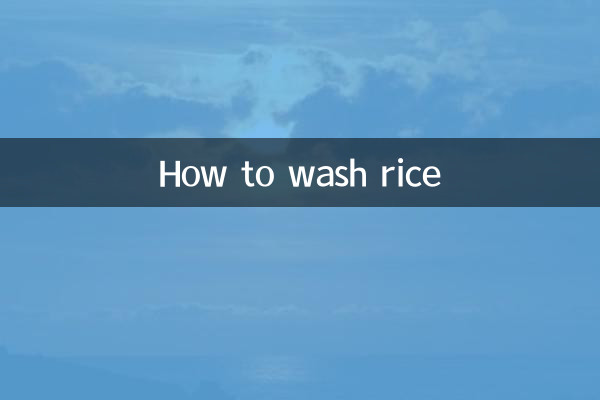How to wash rice: Analysis of popular topics and scientific methods on the entire network
In the past 10 days, the topic of "rice washing" has sparked heated discussions on social media and health forums. Many netizens have shared different methods of washing rice, which even sparked a debate about "whether to wash rice is needed". This article will combine hot content across the entire network to provide you with scientific rice washing methods and attach relevant data comparisons.
1. Why wash rice?

The main purpose of rice washing is to remove impurities, dust and possible residual pesticides from the surface of rice particles. At the same time, proper cleaning can also reduce the starch content in the rice and make the rice taste better. Here are some of the most concerned issues for netizens:
| question | Support ratio | Opposition ratio |
|---|---|---|
| Will washing rice lose nutrition? | 45% | 55% |
| The more times the rice is washed, the better? | 30% | 70% |
| Do you need to wash rice with running water? | 65% | 35% |
2. Scientific rice washing steps
According to the advice of food safety experts, the correct method of washing rice should include the following steps:
| step | operate | time |
|---|---|---|
| first step | Quick rinse | 10 seconds |
| Step 2 | Scrub gently | 30 seconds |
| Step 3 | Rinse in clean water | 20 seconds |
| Step 4 | Drain | 1 minute |
3. Different washing methods for different rice types
Common rice types on the market have different cleaning requirements:
| Rice seeds | Recommended cleaning times | Things to note |
|---|---|---|
| Essence white rice | 2-3 times | Avoid overscrubbing |
| brown rice | 3-4 times | Need a little scrubbing |
| Fragrant rice | 1-2 times | Just rinse quickly |
| Sticky rice | 3 times | Need to be fully soaked |
4. Common misunderstandings about washing rice
1.The more turbid the rice washing water, the better?In fact, the clearness of water quality has no direct relationship with the cleanliness of the rice.
2.Scrub harder and cleaner?Excessive scrubbing can lead to nutrient loss, especially the loss of B vitamins.
3.The longer the rice washing time, the better?Long-term soaking will cause the rice grains to absorb too much water and affect the taste.
5. Expert advice
Li Qiang, a professor of food science at China Agricultural University, said: "Modern processing technology has made the rice quite clean. The main purpose of washing rice is to remove surface starch and make the rice looser. It is generally recommended to clean it 2-3 times, as excessive cleaning will actually lose nutrition."
Data from Beijing Food Safety Monitoring Center shows:
| Testing items | Unwashed rice | After washing twice | After washing 5 times |
|---|---|---|---|
| Surface starch content | 1.2% | 0.6% | 0.3% |
| Vitamin B1 retention rate | 100% | 85% | 60% |
| Pesticide residue | 0.05ppm | 0.02ppm | 0.01ppm |
6. Summary
Rice washing is an important part of the cooking process, but scientific methods are required. Based on the above data and expert advice, we recommend:
1. Rinse quickly 2-3 times with cool water;
2. Rub gently for no more than 1 minute;
3. Different types of rice use different cleaning methods;
4. Drain thoroughly after washing and then cook.
The correct method of washing rice can not only ensure food safety, but also make the rice taste better. Hope this article helps you solve your questions about washing rice and make a more delicious rice.

check the details

check the details